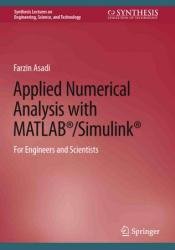Applied Numerical Analysis with MATLAB/Simulink: For Engineers and Scientists
- Добавил: literator
- Дата: 18-12-2022, 20:51
- Комментариев: 0
 Название: Applied Numerical Analysis with MATLAB/Simulink: For Engineers and Scientists
Название: Applied Numerical Analysis with MATLAB/Simulink: For Engineers and ScientistsАвтор: Farzin Asadi
Издательство: Springer
Год: 2023
Страниц: 327
Язык: английский
Формат: pdf (true)
Размер: 19.0 MB
This textbook provides a compact but comprehensive treatment that guides students through applied numerical analysis, using MATLAB/Simulink. Ideal as a hands-on source for courses in Numerical Analysis, this text focuses on solving problems using market-standard software, corresponding to all key concepts covered in the classroom. The author uses his extensive classroom experience to guide students toward deeper understanding of key concepts, while they gain facility with software they will need to master for later studies and practical use in their engineering careers.
Numerical analysis is the branch of mathematics that is used to find approximations to difficult problems such as finding the roots of nonlinear equations, integration involving complex expressions, and solving differential equations for which analytical solutions do not exist. It is applied to a wide variety of disciplines such as business, all fields of engineering, computer science, education, geology, meteorology, and others.
Many good books are written about the numerical analysis theories. In this book, we don’t focus on the theories of numerical analysis. Instead we focus on solving numerical analysis problems with the aid of tools that MATLAB/Simulink provides for us. This book can accompany and complete any standard theoretical textbook on numerical analysis. The prerequisite for this book is a first course on numerical analysis, and no prior knowledge of MATLAB/Simulink is assumed.
This book is written primarily for students of engineering and science. However, it can be useful for anyone who wants to solve a numeric problem with MATLAB/Simulink. For instance, master or Ph.D. students can use the material presented here to solve the numerical problems of their thesis or papers. All of the material presented here can be covered in one semester (14 weeks) with 3 h per week.
This book is composed of 11 chapters. Here is a brief summary of each chapters:
• Chapter 1 is an introduction to MATLAB. In this chapter, you will learn how to do basic calculations with MATLAB. Basic matrix operations, trigonometric, hyperbolic, logarithmic, exponential, and many other important functions are studied in this chapter.
• Chapter 2 shows how MATLAB can be used for symbolic calculations. In this chapter, you will learn to calculate limits, derivatives, integrals (both definite and indefinite), partial fraction expansion, Laplace transform, Fourier transform, and Taylor series with MATLAB.
• Chapter 3 shows how MATLAB can be used to calculate a definite integral (single, double or triple) or derivative of a function at a given point. Trapezoidal and Simpson rules for calculation of definite integrals are studied in this chapter.
• Chapter 4 shows how MATLAB can be used for statistical calculations. In this chapter, you will learn how to calculate summation, average, variance, and standard deviation of a given data, how to generate random numbers, how to calculate factorial and combinatorial, and how to obtain cumulative distribution function for a normal distribution.
• Chapter 5 shows how MATLAB can be used to obtain impulse and step responses of a linear differential equation. In this book, we use the linear system (or linear dynamical system) and linear differential equation terms interchangeably. By impulse and step responses, we mean the response that observed in the output when the input is Heaviside step function and Dirac impulse function, respectively.
• Chapter 6 shows how differential equations can be solved with Simulink. Simulink is a software package which accompanies MATLAB and permits you to simulate dynamical systems (i.e., systems which can described by a linear or nonlinear differential equations) with the aid of many ready to use graphical blocks.
• Chapter 7 shows how difference equations can be solved with Simulink. A difference equation is a relation between the differences of unknown function at one or more general values of the independent variable. Generally, a difference equation is obtained in an attempt to solve an ordinary differential equation by finite difference method.
• Chapter 8 shows how curve-fitting problems can be solved with MATLAB’s Curve Fitting Toolbox. Curve fitting is the process of constructing a curve, or mathematical function, that has the best fit to a series of data points.
• Chapter 9 shows how MATLAB can be used for drawing the graph of a given data. Different kind of graphs are studied in this chapter.
• Chapter 10 shows how some of well-known numerical analysis algorithms can be implemented with MATLAB programming.
• Chapter 11 shows how optimization problems can be solved with the aid of ready to use functions that Optimization Toolbox provides.
Скачать Applied Numerical Analysis with MATLAB®/Simulink®: For Engineers and Scientists
Внимание
Уважаемый посетитель, Вы зашли на сайт как незарегистрированный пользователь.
Мы рекомендуем Вам зарегистрироваться либо войти на сайт под своим именем.
Уважаемый посетитель, Вы зашли на сайт как незарегистрированный пользователь.
Мы рекомендуем Вам зарегистрироваться либо войти на сайт под своим именем.
Информация
Посетители, находящиеся в группе Гости, не могут оставлять комментарии к данной публикации.
Посетители, находящиеся в группе Гости, не могут оставлять комментарии к данной публикации.
